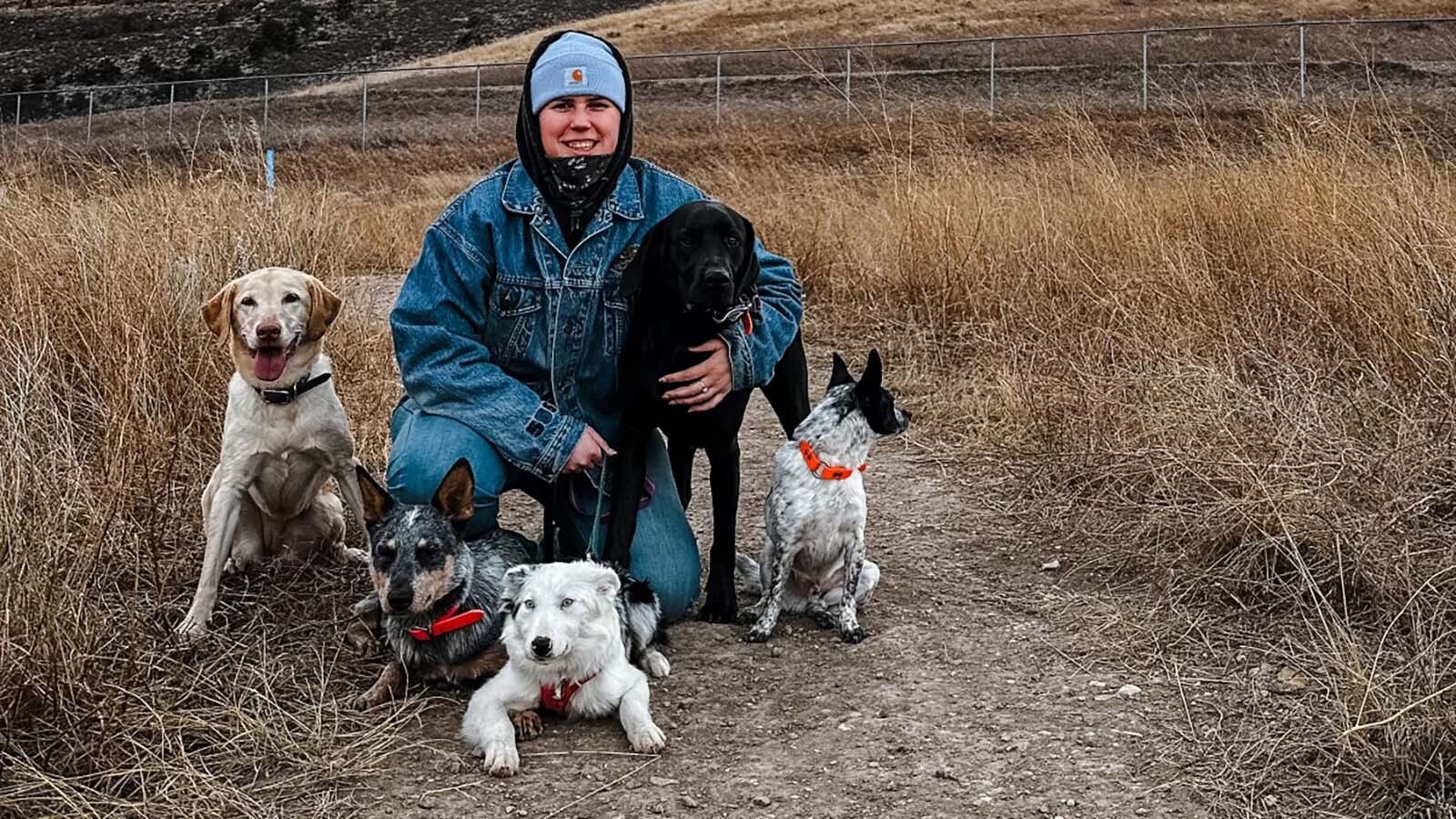Paleontologists from the Children’s Museum of Indianapolis are all smiles after finding the lethal grin of their prized Late Jurassic Allosaurus in the Bighorn Basin.
Paleontologists from the Children’s Museum of Indianapolis and the Naturalis Biodiversity Center in the Netherlands found the nearly complete skeleton of the carnivorous dinosaur from the “Jurassic Mile,” an excavation in the 150-million-year-old Morrison Formation near Lovell.
Excavations in Summer 2024 uncovered the final few inches from the face of this toothy terror this summer. Laura Rooney, curator of paleontology at the Children's Museum, described it as “a perfect, beautiful fossil.”
“You don’t see this like this,” she said. “All of the teeth are beautifully preserved inside that snout with the mouth slightly open. It's perfect. It's gorgeous. There was much rejoicing.”
Schrodinger's Dinosaur
The Allosaurus skeleton found in the Jurassic Mile is nearly complete and partially articulated, including almost the entire tail, the complete hips and legs, the torso and neck, and – best of all – a complete skull.
Paleontologists recovered the back end of the skull in 2023 and returned to recover what was left this summer. They had already sniffed out the snout and just had to remove it from the sandstone encasing it.
“We found a little bit of tooth poking out of the rocks and said, ‘Alright, this is the spot,’” Rooney said. “So, we started working to get that block out, which is quite a fuss. It’s not as easy as pulling the rock out. You want it to break along the cracks that already exist.”
The existing cracks were gently exploited using the forks of a skid steerer. Then, the fossil unexpectedly separated from the rock, which Rooney described as “silence in a moment of panic.”
“You could feel it and hear it fall,” she said. “This is Schrodinger's dinosaur, at this point. If you don't look at it, it could either be a beautiful, perfect separation, or the whole thing is shattered into a million pieces.”
Rooney summoned enough courage to look into the void. She saw a row of shiny serrated teeth, beautifully preserved and mostly undamaged.
At that moment, Rooney said everyone in the vicinity started working like a “well-oiled machine” to finish extracting the serrated snout while ensuring it didn’t crumble or crack.
“Pandora's box is open at this point,” she said. “We needed to work carefully and quickly to get this thing out. Each of us kind of instinctively knew what had to be done next. One of us ran up to get glue and padding to support the fossil, other people were collecting some crumbles of teeth, and our lead paleontologist, Joseph Frederickson, and I were discussing how to maneuver this thing safely. It was probably five minutes, but it felt like 30 minutes.”
Disarming Discovery
Ultimately, the Allosaurus snout came out in one solid block. The tips of the upper and lower jaws were intact, so cleanly exposed that it looked like they had spent several hours being exposed in the museum’s fossil preparation lab.
That’s where the snout can be seen today, as the rock encasing it and the rest of the skull is delicately etched away with dental picks and pneumatic air scribes. Visitors at the Children’s Museum of Indianapolis will see the Allosaurus’s smile through the prep lab’s window.
“We're going to spend the next couple of years working on this guy,” Rooney said. “It will be a slow process because we are trying to dot our i's and cross our t's with everything, making sure that we preserve every part of the fossil that we can and potentially find those missing bits.”
The “missing bits” Rooney referred to are the Allosaurus’s arms. Despite the completeness of the mostly articulated specimen, the only arm bone they’ve discovered is a single hand claw.
Rooney finds the lack of Allosaurus arm bones disarming but isn’t giving up hope. Those fossils may still be hidden in the larger blocks they have yet to prepare.
“Those darn arms are the only things we’re missing,” she said. “Behind the skull, that's the coolest part of the dinosaur for me. Those arms are separated from the rest of the skeleton, but it’s possible they are somewhere in the blocks of rock with the other bones we've been working on. We just need to keep looking.”
Skin In The Game
Another reason for the meticulously slow and cautious preparation of the Allosaurus specimen is the remarkable skin impressions uncovered along the articulated skeleton. Scaly impressions of the dinosaur’s reptilian body have been found along most of the right side of its skeleton.
“There are extensive skin impressions on this guy,” Rooney said. “When this animal died, it was laid down on its right side, and the skin was pressed up into the mud, and that layer preserved. We've got skin impressions going along the hips, the tail, and the neck.”
These extensive skin impressions could reveal new information on the life and look of Allosaurus, which in turn could answer questions about what Wyoming was like during the Late Jurassic Period.
That’s why Rooney and the rest of her team aren’t in any rush to finish their work on the Allosaurus specimen. With every day and every millimeter, they’re making small steps toward big discoveries.
“We want to do justice to this specimen,” she said. “We will release more information as research gets completed, but the fossils are still available for people to see at our museum at any time while we're researching and working on them.”

Every Inch In The Mile
The articulated, impressionable Allosaurus might be the most exciting fossil from the Jurassic Mile. But there’s much more potential in the 150-million-year-old rocks in the northeast corner of the Bighorn Basin.
Two large sauropod skeletons from the Jurassic Mile are already mounted at the Children’s Museum of Indianapolis. Meanwhile, Rooney said many of the biggest discoveries have come from much smaller creatures.
“The things we’re most excited about is finding more of the lesser known, non-dinosaur critters of the Jurassic,” she said. “When you're comparing their fossils to the 6-foot-long bones we're used to working on, finding these little guys can be difficult.”
Several small aquatic fossils from fish and snails have proved to be exciting insights into the environment where the Allosaurus was nosing around. Rooney added that the team is researching fossils they’ve found of the Jurassic ancestors of the lizard-like tuatara.
“Tuataras used to be far more common during the Jurassic, and there was a great variety of species, but we have only one species left of them alive today,” she said. “We've found itty bitty fossils from these guys. We're talking less than an inch.”
These small fossils contribute to the much larger picture of Late Jurassic Wyoming—every inch counts in the Jurassic Mile.
“We're trying to focus a little bit more on those microfossils, hoping that we can expand our understanding of the diversity of animals that we're living in Wyoming at this time,” Rooney said. “We don't find as many of those fossils, but they tell an interesting story that pieces together the whole ecosystem.”
But there are plenty of big bones from big animals, too. There was never a shortage of sauropods in the Late Jurassic
“There are many more sauropod fossils to be found at the Jurassic Mile,” Rooney said. “Lots and lots of long-necked dinosaur material at that site.”
Turned Up Nose
Future discoveries at the Jurassic Mile might be more spectacular and scientifically valuable than the articulated Allosaurus skeleton. However, the successful removal of the snout with its “beautiful teeth” exposed in the Wyoming air is a moment that’s unlikely to be topped for Rooney.
“It’s like the beginning of Jurassic Park, where you see them pick up a paintbrush and gently dust off a perfect, beautiful fossil,” she said. “That never happens, but there it is.”
Andrew Rossi can be reached at arossi@cowboystatedaily.com.












